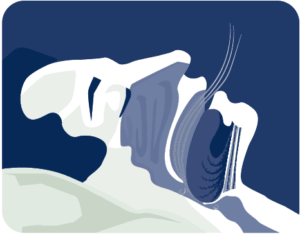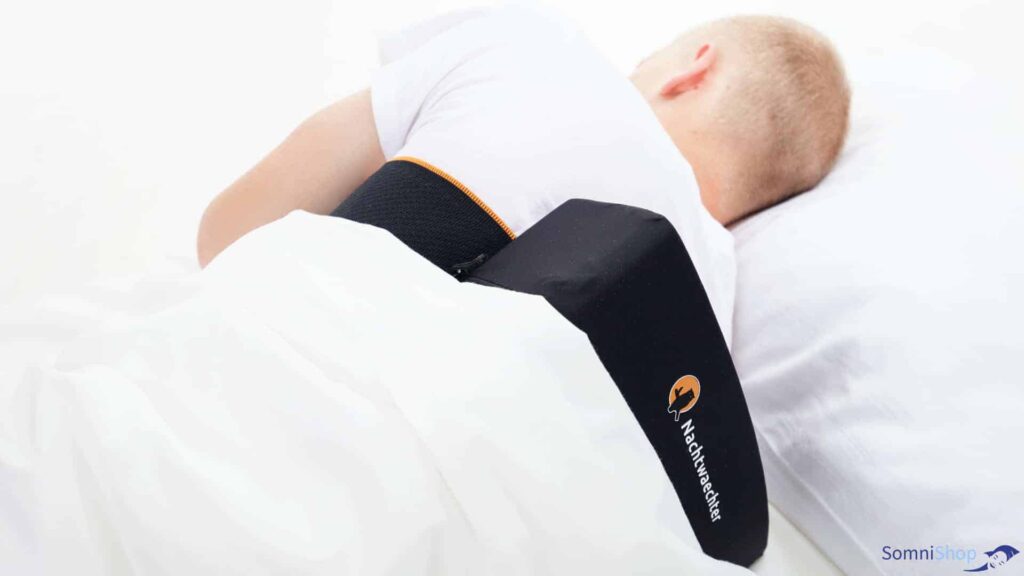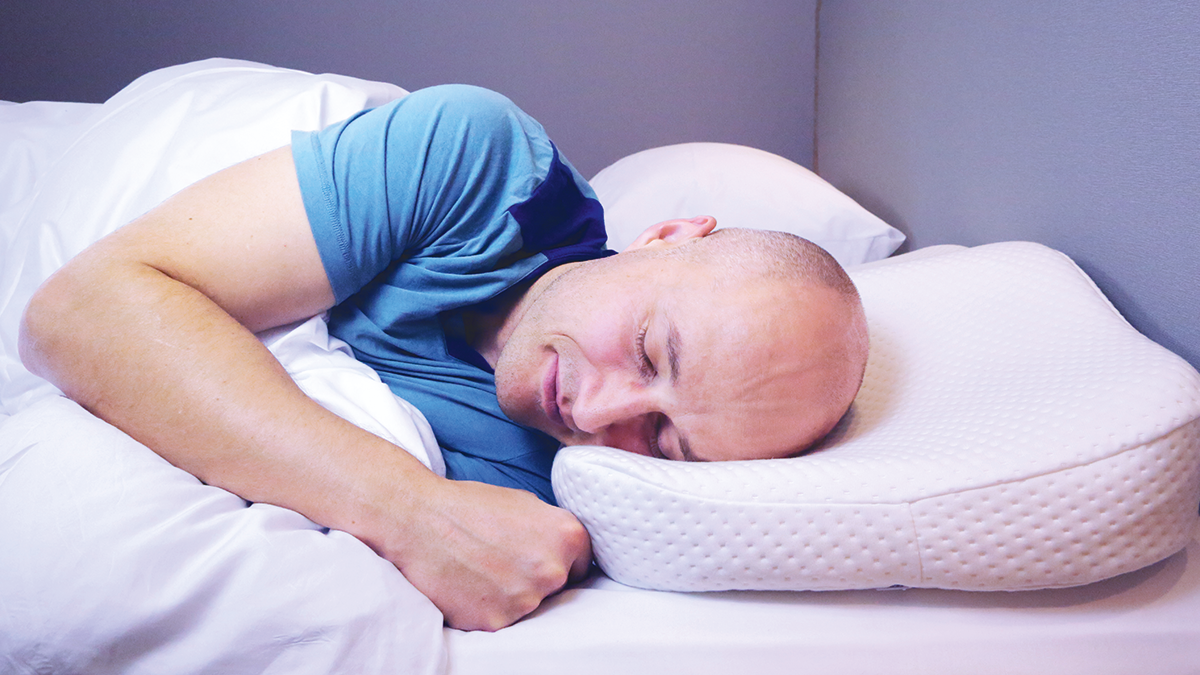A major cause of snoring is that the tongue slides back into the throat during sleep (so-called tongue snoring). Because of gravity, this only occurs when you sleep on the back. An anti-snoring pillows help you to sleep on the side. We look into that and tell you for whom they are great – and for whom not.
Stop sleeping on your back – Help for tongue-based snorers
When you snore while you sleep on your back, the cause is most often your tongue. When the tongue muscles relax, the rear part of the tongue – the base of the tongue – slides back into the throat. The reason for this is the gravitational forces that pull on the tongue: The tongue base narrows or obstructs the airways as it slides back. The air you breathe , however, has to pass through the constricted area. This results in turbulence ,which causes the surrounding tissue to vibrate . This process produces the sound we perceive as snoring. Dr. Hartmut Grüger (somnologist and chief physician at the Medical Center Düsseldorf, Germany) estimates that approximately 30% of all snorers are tongue-based snorers, i.e. the cause of their snoring is that the tongue falls back into the throat.

Anti-Snoring Pillow, Positional Therapy Belt or Anti-Snoring Backpack: Three Devices, One Approach
In such a case, positional therapy can help. Positional therapy includes all products that help you to sleep on your side or on your stomach. When lying on your back, gravity forces the base of the tongue to slide down your throat – this is not the case when you sleep on your stomach or on your side. It is important to keep in mind that positional therapy only helps for tongue-based snoring, i. e. only when you snore while lying on your back. When you are also affected by snoring when lying on your side, then positional therapy won’t help you. If you want to find out more about which product types might help you, then you should consider doing our snoring test.
The most popular positional therapy product is the anti-snoring pillow, followed by snoring vests and anti-snoring backpacks. Positional therapy products have a similar effect to your partner nudging you to make you turn over when you snore. The benefit of positional therapy devices is that with these sophisticated products, neither you nor your partner will wake up. All these positional therapy products are based on the principle of the “Princess on the Pea”. In other words, when you lie on the pea ( in this case, your back), the discomfort should cause you to roll onto your side.
How an Anti-Snoring Pillow Works
A typical anti-snoring pillow is elevated in the middle (it looks a little bit like the Swiss Matterhorn”), which also makes it uncomfortable to sleep on when lying on the back. Instead, the head automatically turns sideways, either to the left or the right so that you are forced to sleep on your side. Pillows that help stop snoring support the head, relieve pressure on the neck and ensure that your nights remain free of snoring. Most anti-snoring pillows are made of comfortable memory foam and have a nice, skin-friendly cover. One additional advantage of an anti-snoring pillow (in contrast to other positional therapy devices like a snoring belt) is that It is absolutely inconspicuous – there is nothing that makes it identifiable as a snoring aid!
How Do Anti-Snoring Backpacks and Anti-Snoring Positional Therapy Trainers Work?
Positional therapy training devices: anti-snoring backpacks or sleeping vests both work on the same principle of providing an obstacle to prevent you from sleeping on your back To change sides you can roll over your stomach. This obstruction is provided either in the form of a cushion or a foam wedge.
With the help of waist and chest straps, these products can be individually adjusted, thus the fit is customised especially for you. The straps are usually padded so that they are comfortable to wear and do not cut the skin. The material chosen ensures that there is no heat build-up.
Positional therapy devices help you to modify your behaviour and sleeping positions. As a result, they have the same effect as positional exercises would have. If they are continuously worn over several months, the brain becomes accustomed to sleeping on the side. Once this has been achieved , you no longer need to wear an anti-snoring backpack or a positional therapy belt, because you have become used to sleeping on your side and therefore automatically adopt this position.

There are many tips for “homemade” positional therapy devices on the internet. Among these is the “tennis ball” technique: it involves sewing a tennis ball into the back of the pyjamas, which is supposed to prevent you from sleeping on your back. If that seems uncomfortable to you, it’s because it really is! You also risk sleeping on your back regardless of the tennis ball, because pyjamas are generally too large for the tennis ball that is sewn into the back, to stay in place.
Positional Therapy – Great Treatment for Position-Dependent Sleep Apnoea
Even in the treatment of pathological snoring, especially obstructive sleep apnoea syndrome (OSAS), positional therapy has a significant role to play. If you suffer from position-dependent obstructive sleep apnoea (POSA), positional therapy can be a great first-line treatment (and a good alternative to continuous positive airway pressure or CPAP / CPAP machines). Please note that this is, however, only the case when your OSAS is position-dependent, i.e., you only snore when you sleep on the back. When you experience breathing interruptions when you sleep on your side, then an anti-snoring pillow or a positional therapy belt will not help you.
Our final warning: If you suffer from mild to moderately severe OSAS, these products usually have the same effect on the apnoea-hypopnea-index (AHI) as CPAP-therapy has. The number of breathing interruptions (apnoeic episodes) that occur per hour could be reduced to less than five. In case of severe OSAS, positional therapy will usually not reduce the AHI enough. We therefore recommend the use of positional therapy training devices in mild to moderate sleep apnoea cases. An anti-snoring pillow like the Posiform might also be suitable for the treatment of mild sleep apnoea.
Please note: this information cannot replace medical advice. Before you embark on any form of treatment, we advise you to consult your doctor.

Managing Director
Hannes Wakonig comes out of the Marketing and Finance branch and has previously worked in the field of medical technology. He is the co-founder and managing director of SomniShop (health.On Ventures GmbH) and AescuBrands.





 Welcome to SomniShop
Welcome to SomniShop